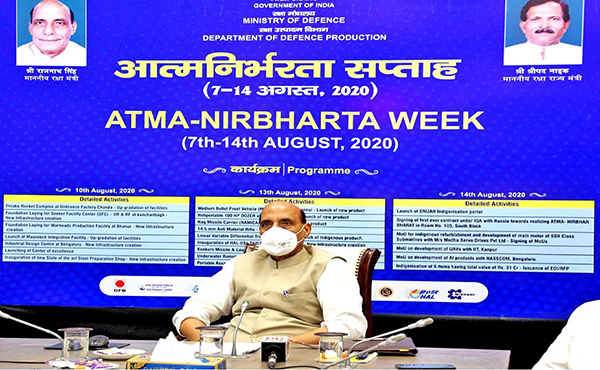The list was prepared by MoD after several rounds of consultations with all stakeholders, including Army, Air Force, Navy, Defence Research & Development Organisation (DRDO), Defence Public Sector Undertakings (DPSUs), Ordnance Factory Board (OFB) and private industry to assess current and future capabilities of the Indian industry for manufacturing various ammunition/ weapons/platforms/equipment within India. The list was released on 9 August.
Almost 260 schemes of such items were contracted by the three Services at an approximate cost of Rs 3.5 lakh crore between April 2015 and August 2020. With latest embargo on import of 101 items, it is estimated that contracts worth almost Rs 4 lakh crore will be placed upon the domestic industry within the next five to seven years. Of these, items worth almost Rs 1.3 lakh crore each are anticipated for the Army and the Air Force while items worth almost Rs 1.4 lakh crore are anticipated by the Navy over the same period.
The list of 101 embargoed items comprises of not just simple parts but also some high technology weapon systems like artillery guns, assault rifles, corvettes, sonar systems, transport aircrafts, light combat helicopters (LCHs), radars and many other items to fulfil the needs of our Defence Services. The list also includes, wheeled armoured fighting vehicles (AFVs) with indicative import embargo date of December 2021, of which the Army is expected to contract almost 200 at an approximate cost of over Rs 5,000 crore.
Similarly, the Navy is likely to place demands for submarines with indicative import embargo date of December 2021, of which it expects to contract about six at an approximate cost of almost Rs 42,000 crore.
For the Air Force, it is decided to enlist the light combat aircraft LCA MK 1A with an indicative embargo date of December 2020. Of these, 123 are anticipated at an approximate cost of over Rs 85,000 crore. Hence, there are highly complex platforms that are included in the list of 101 items, of which details of three examples are given above.
The embargo on imports is planned to be progressively implemented between 2020 to 2024. The aim behind promulgation of the list is to apprise the Indian defence industry about the anticipated requirements of the Armed Forces so that they are better prepared to realise the goal of indigenisation. The MoD has adopted many progressive measures to encourage and facilitate ‘Ease of Doing Business’ by the defence production entities. All necessary steps would be taken to ensure that timelines for production of equipment as per the Negative Import List are met, which will include a co-ordinated mechanism for hand holding of the industry by the Defence Services.
More such equipment for import embargo would be identified progressively by the DMA in consultation with all stakeholders.
A due note of this will also be made in the Defence Acquisition Procedure (DAP) to ensure that no item in the negative list is processed for import in the future.
In another relevant step, the MoD has bifurcated the capital procurement budget for 2020-21 between domestic and foreign capital procurement routes. A separate budget head has been created with an outlay of nearly Rs 52,000 crore for domestic capital procurement in the current financial year.
Clarification
Consequent to release of the negative list of items for import by the MoD on 9 August 2020, certain queries were raised by industry with respect to inclusion of some of the items like the Light Combat Aircraft (LCA) Mark 1A, Pinaka Rocket System and Akash missile system, which are manufactured in India. It was highlighted that such systems, etc, were developed with qualitative requirements framed by the defence forces. Such systems were also available in the international market.
Nomenclature of such weapon systems have been included in the negative list of imports to ensure that the Defence Services did not go in for procurement of similar systems ex-import. It was also highlighted that for a product to be considered as an indigenous system, the percentage of indigenous content has to meet minimum laid down specifications. Hence, manufacturers were also required to ensure indigenisation and decrease import content to the permissible limits.
Comments
This is a big step towards self-reliance in defence. It also offers a great opportunity to the Indian defence industry to rise to the occasion to manufacture the items in the negative list by using their own design and development capabilities or adopting the technologies designed and developed by Defence Research and Development Organisation (DRDO) to meet the requirements of the Armed Forces in the coming years.













[…] ALSO READ Import Embargo as Part of Atmanirbhar Initiative […]